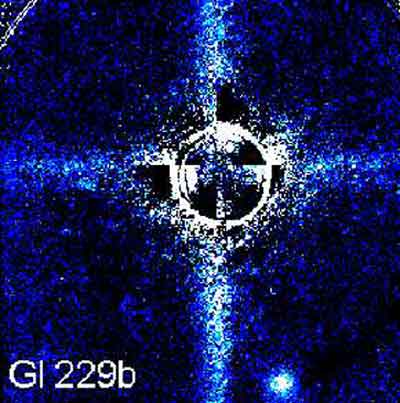Explanation: The spot near the bottom is an image of an unusual type of object: a brown dwarf. A brown dwarf is sometimes called a "failed star" because it does not have enough mass to shine by nuclear fusion. A brown dwarf is more massive than a planet, though, and thought to have formed through stellar-like nebular condensation. Brown dwarfs and planets are likely quite abundant, but usually difficult to see in the glare of brighter stars they orbit. New techniques, such as using coronagraphic masks to block the light of the bright star, are allowing the detection of these faint stellar companions. Above, much of the bright light of central Gliese 229A has been blocked and digitally subtracted, leaving the clearest image yet of Gliese 229B. Perfecting techniques like this increases ability to detect still dimmer Earth-type planets orbiting nearby stars.
1999 2000 2001 2002 2003 2004 2005 2006 2007 2008 2009 2010 2011 2012 2013 2014 2015 2016 2017 2018 2019 2020 2021 2022 2023 2024 2025 |
Январь Февраль Март Апрель Май Июнь Июль Август Сентябрь Октябрь Ноябрь Декабрь |
NASA Web Site Statements, Warnings, and Disclaimers
NASA Official: Jay Norris. Specific rights apply.
A service of: LHEA at NASA / GSFC
& Michigan Tech. U.
|
Публикации с ключевыми словами:
planet - dwarf galaxy - brown dwarf - коричневый карлик
Публикации со словами: planet - dwarf galaxy - brown dwarf - коричневый карлик | |
См. также:
Все публикации на ту же тему >> | |
